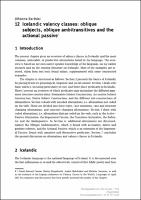Chapter 12 Icelandic valency classes
oblique subjects, oblique ambitransitives and the actional passive
| dc.contributor.author | Barðdal, Jóhanna | |
| dc.contributor.editor | Malchukov, Andrej | |
| dc.contributor.editor | Comrie, Bernard | |
| dc.date.accessioned | 2019-11-19 23:55 | |
| dc.date.accessioned | 2020-01-07 16:47:06 | |
| dc.date.accessioned | 2020-04-01T09:26:25Z | |
| dc.date.available | 2020-04-01T09:26:25Z | |
| dc.date.issued | 2015 | |
| dc.identifier | 1006441 | |
| dc.identifier | OCN: 1135847159 | en_US |
| dc.identifier.uri | http://library.oapen.org/handle/20.500.12657/23703 | |
| dc.description.abstract | The present chapter gives an overview of valency classes in Icelandic and the most common, noticeable, or productive alternations found in the language. The over-view is based on my own native-speaker knowledge of the language, on my earlier research and on the existing literature on Icelandic. Most of the examples are at-tested, taken from real texts found online, supplemented with some constructed examples. The chapter is structured as follows: Section 2 presents the basics of Icelandic by placing it into its genealogical, linguistic and social context. Section 3 deals with basic valency, focusing particularly on two- and three-place predicates in Icelandic. There I present an overview of which predicates may instantiate the different argument structure constructions: Nominative Subject Construction, Accusative Subject Construction, Dative Subject Construction, and the different sub-constructions of ditransitives. Section 4 deals with uncoded alternations, i.e. alternations not coded on the verb. These are divided into three types, case variations, case and structure changing alternations, and structure changing alternations. Section 5 deals with coded alternations, i.e. alternations that are coded on the verb, such as the Active–Passive Alternation, the Impersonal Passive, the Transitive–Inchoative, the Reflexive and the Mediopassive. In Section 6, additional alternations are discussed, namely the Oblique Ambitransitive, which is found with accusative, dative and genitive subjects, and the Actional Passive, which is an extension of the Impersonal Passive, found with transitive and ditransitive predicates. Section 7 concludes the present discussion on alternations and valency classes in Icelandic. | |
| dc.language | English | |
| dc.subject.classification | thema EDItEUR::C Language and Linguistics::CF Linguistics | en_US |
| dc.subject.classification | thema EDItEUR::C Language and Linguistics::CF Linguistics::CFK Grammar, syntax and morphology | en_US |
| dc.subject.other | Valency | |
| dc.subject.other | Verb Classes | |
| dc.subject.other | Argument Alternations | |
| dc.title | Chapter 12 Icelandic valency classes | |
| dc.title.alternative | oblique subjects, oblique ambitransitives and the actional passive | |
| dc.type | chapter | |
| oapen.identifier.doi | 10.1515/9783110338812-016 | |
| oapen.relation.isPublishedBy | 2b386f62-fc18-4108-bcf1-ade3ed4cf2f3 | |
| oapen.relation.isPartOfBook | 230fe2f7-0d96-497a-b8c5-b6d189663f6a | |
| oapen.relation.isFundedBy | 7292b17b-f01a-4016-94d3-d7fb5ef9fb79 | |
| oapen.relation.isbn | 9783110332940; 9783110395273 | |
| oapen.collection | European Research Council (ERC) | |
| oapen.place.publication | Berlin/Boston | |
| oapen.grant.number | 313461 | |
| oapen.grant.acronym | EVALISA | |
| oapen.identifier.ocn | 1135847159 |

